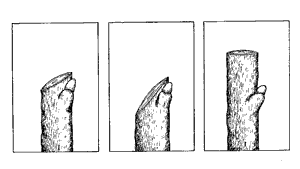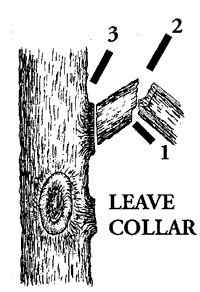When To Prune Trees
Prune out dead wood and diseased or injured limbs any time. In general, prune deciduous trees in the winter, at least a month after all their leaves have fallen and the they are dormant. You can better study their branching pattern in winter, and pruning cuts can begin to heal faster during new spring growth.
To encourage growth, especially branching in fruit trees, prune in mid-summer. Cutting stimulates the development of new tissue at the wound site during the growing season and lots of new branches sprout.
Spring flowering trees such as magnolia bloom on last year's wood from buds they formed last summer. To get maximum bloom, prune just after the trees have flowered, before they start to form new buds for next year. Summer flowering trees bloom on this year's new growth. To encourage more flowering, prune them in early spring or during the winter.
Some trees, such as maple, dogwood, walnut, elm and birch will bleed sap for several days or weeks from pruning cuts made in late winter or early spring. Although it is unsightly, the bleeding does not harm the tree. If you prefer, you can prune them in midsummer while they are in full leaf.
Prune to Control Growth
Sometimes young trees develop two main stems. Carefully cutting away the less vigorous stem assures a single strong central trunk later on.
Lateral branches may grow at too narrow an angle relative to the trunk, making them unsuited to be the “scaffolding,” or permanent branches that support the leaf canopy. Remove these branches while the tree is young. The remaining scaffold branches should be 18 to 24 inches apart along the trunk of the tree, emerging from all sides of the trunk.
Summer pruning tends to retard a tree’s growth rate the following year, while winter pruning encourages renewed spring growth. Finally, pruning out selected branches of flowering trees before bloom reduces the number of blooms, but the remaining blooms are typically larger.
Prune for Tree Health and Safety
Sometimes pruning is necessary to remove dead, diseased or damaged branches before insects and diseases, which exploit these injuries as a way to access the interior of the tree, spread to the rest of the tree. It may be necessary to correct situations where branches that are rubbing each other, opening wounds in their protective bark. Also, remove any branches, such as suckers or “sprouts” that grow along the limbs, crowding each other and producing excess foliage that inhibits wind and sun from penetrating the center of the canopy and mars the appearance of the tree.
Prune to correct potentially dangerous situations such as weakened branches that may topple over to damage the house or car, pull down electric lines, and cause injury or death. Trees planted in the wrong spot--encroaching upon utility lines, crowding walls, hanging over roofs and gutters--need frequent pruning. If a tree is too big for its location, judicious pruning can reduce its size without destroying its looks and shape.
Making the Cut
 |
| Cut in middle is Right Cuts on left and right are Wrong |
A proper pruning cut is 1/8 to 3/8 inches above a leaf bud and angled parallel to the direction the bud is pointing. When pruning off part of an outside branch, always cut to an inside bud. Also keep these pointers in mind:
Overpruning can kill or damage a tree, so be certain to maintain at least 2/3 of the live tree when pruning.
When cutting out dead wood, always cut back where healthy wood exists.
When trimming a healthy branch, always cut back to another branch or bud where new growth is starting.
Avoid leaving any stubs, even when pruning a small shoot or twig. Stubs do not heal over properly and will eventually dry and crack, providing a source of entry for disease and insects.
NEVER, never “top” or head back a tree trunk or major stems. This causes lots of weak shoots to develop at the end of each stub, destroys the natural form of the tree, and progresses to dieback and decay.
Target Pruning
 |
When cutting a limb from the main trunk, avoid cutting “flush” with the surface of the trunk. Research by Dr. Alex Shigo, a U.S. Forest Service researcher and consultant, has established that trees respond best to a method called “target pruning.” Follow these steps:
Locate the branch bark ridge, or BBR. The BBR is a dark line, or seam of bark, where the bark of the branch you plan to cut meets the bark of the trunk. It angles away from this natural junction and looks like an inverted V when viewed end-on. This is “Target A” as shown.
Locate “Target B” as shown. This is the junction of the branch and trunk, and is called the branch collar. This slightly swollen junction is transition bark and is a natural shedding point. Its special tissues contain critical chemicals to defend against disease and insect invasion and promote healing. It is important to preserve this tissue when you cut, even though it leaves a swollen knob there.
Cut off a large portion of the branch out away from the trunk by sawing up from under it. This removes the bulk and weight of most of the branch and prevents inadvertent stripping of the bark of the trunk during the critical final cut near the branch collar.
Make the final cut at the branch collar (from points A to B), sawing down from the top of the limb as smoothly as possible to promote healing.
Keeping Safe
Whether you use a hand pruner or a chainsaw, you will never regret spending a bit more money for some good safety equipment. A pair of heavy duty gloves is essential during and after pruning. They improve your grasp of these limbs materials and tools, and they prevent scratches and blisters. If you are working in tree growth that is dense or thorny, consider wearing safety goggles.
If you are working around the area where professional arborists are climbing and cutting you and any bystanders must wear a hard hat. If you are going to use a chainsaw, wear ear protectors as well. Finally, consider using chainsaw chaps to protect your legs.
About Tree Paint
Trees have the ability to compartmentalize injuries, sealing them off from their main systems. When a tree loses a branch, certain chemicals in the bark collar cells trigger the development callus tissue to gradually cover the wound. Research shows that, because of this, healthy trees are capable of healing themselves without any help from tree paint, asphalt, creosote, wound dressing, shellac, varnish, or other artificial sealants.
If pruning is done improperly, no sealant will stop the decay. In fact, there is some evidence that sealants promote the spread of decay within tree tissues by trapping moisture inside the wound. Do not paint, wrap or otherwise cover pruning wounds on trees.

